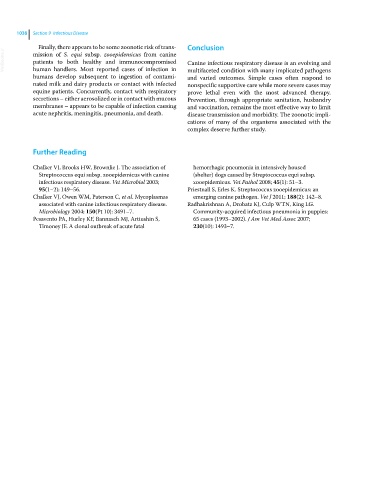Page 1100 - Clinical Small Animal Internal Medicine
P. 1100
1038 Section 9 Infectious Disease
Finally, there appears to be some zoonotic risk of trans- Conclusion
VetBooks.ir mission of S. equi subsp. zooepidemicus from canine Canine infectious respiratory disease is an evolving and
patients to both healthy and immunocompromised
human handlers. Most reported cases of infection in
humans develop subsequent to ingestion of contami- multifaceted condition with many implicated pathogens
and varied outcomes. Simple cases often respond to
nated milk and dairy products or contact with infected nonspecific supportive care while more severe cases may
equine patients. Concurrently, contact with respiratory prove lethal even with the most advanced therapy.
secretions – either aerosolized or in contact with mucous Prevention, through appropriate sanitation, husbandry
membranes – appears to be capable of infection causing and vaccination, remains the most effective way to limit
acute nephritis, meningitis, pneumonia, and death. disease transmission and morbidity. The zoonotic impli-
cations of many of the organisms associated with the
complex deserve further study.
Further Reading
Chalker VJ, Brooks HW, Brownlie J. The association of hemorrhagic pneumonia in intensively housed
Streptococcus equi subsp. zooepidemicus with canine (shelter) dogs caused by Streptococcus equi subsp.
infectious respiratory disease. Vet Microbiol 2003; zooepidemicus. Vet Pathol 2008; 45(1): 51–3.
95(1–2): 149–56. Priestnall S, Erles K. Streptococcus zooepidemicus: an
Chalker VJ, Owen WM, Paterson C, et al. Mycoplasmas emerging canine pathogen. Vet J 2011; 188(2): 142–8.
associated with canine infectious respiratory disease. Radhakrishnan A, Drobatz KJ, Culp WTN, King LG.
Microbiology 2004; 150(Pt 10): 3491–7. Community‐acquired infectious pneumonia in puppies:
Pesavento PA, Hurley KF, Bannasch MJ, Artiushin S, 65 cases (1993–2002). J Am Vet Med Assoc 2007;
Timoney JF. A clonal outbreak of acute fatal 230(10): 1493–7.

